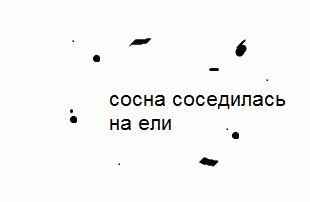10 paper encryption methods for schoolchildren with ABBYY FineReader

Way times
Create encryption

Copy the text in MS Word, make it the same size and formatting, and apply to it any ikonochny font, such as Webdings or any other. Print and send the received encryption to a friend.
Your friend, of course, is a sailor, and will read the encryption quickly and easily. But imagine that you sent a friend not a line, but many lines. What to do then?
')
Preparation for decoding
Key creation
In order for your friend to easily decipher it, he needs to transfer the key. In some cases, the key can create it. But we will help him in this difficult task and, similarly to encryption, create the following file:

The attentive reader may notice that there are exactly 26 flags here and assume that he sees the English alphabet in front of him, and, of course, he will be right.
Creating standards
Scan the key in FineReader. We select the English language recognition, recognition with training and prohibit the use of built-in standards. Click "Recognize". Now, each letter will be asked what the letter is:

We type in turn the letters of the alphabet and click "Train". 52 clicks - and the standard is ready. Do not forget to save the standards for future use, otherwise the training will have to be done every time. The resulting standards can be viewed in the standards editor:

This whole process takes 5-10 minutes, but may take longer if you do not know the location of the English letters. In this case, it is recommended to mark already used keys on the keyboard in order to speed up the search for the remaining ones.
Decryption
Now turn off the learning mode, scan and recognize the encryption text itself. Voila - and we have the result:

An attentive reader will say: so what? Why do you need it? Oddly enough, this can be found many applications, for example:
• create standards for the xkcdRightHand font and easily extract texts from images of your favorite comic book;
• create standards for some non-standard font and digitize the old book;
• carry out a quick search in elvish books written in tengvare or kertar;
• assistance in digitizing texts whose author considers himself the most intelligent and inserts strange characters everywhere.
The beginner conspiracy theorist will say that to crack such a cipher is just to spit: we look at the statistics of the use of letters, we analyze short words - and the key is solved. In this case, add garbage symbols to the source code, or encode it in Base64. Now imagine that, for example, the f-font is used for encryption:

I think in a couple of minutes of visual analysis, there will be only J. in my head.
Method two
Create encryption
We take the book from the shelf, which is not a pity. I am sure that now there will be people who say that there are no such books. But believe me: since you have embarked on the path of encryption, then there should be nothing sacred for you. Therefore - go ahead. We take the book, and (it’s better not to read the impressionable), we remember that we want to convey only one word: “pine”, leaf through the book, find what we are looking for on page 117, and modify:

We close the book and send it to a friend.
Preparation for decoding
Making up secret words
Let us agree in advance with a friend a set of secret words that must satisfy the following condition: they must contain the letters "c" or "l", for example, pine, get rid of, speech therapist.
Creating a dictionary
A friend saves these words to a txt file, with a few changes: OS, EKVIT, poged; then it imports it into the user dictionary of the newly created language in FineReader:

Decryption
We scan the resulting book and recognize it in our language. We are looking for modified words in the text, we find the "Ososa" and rejoice. Thus having

In general, the creation of your own dictionaries allows you to improve the recognition of frequently occurring proper nouns, abbreviations, and alphabet sequences, for this you can specify a regular expression for checking in the user language instead of the dictionary.
And we want to finish with the following words:

Source: https://habr.com/ru/post/255125/
All Articles